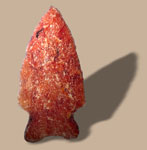|
|
|
A Collection of Stone Tools from AlbertaHumans have lived in Alberta since the end of the last ice age - about 13,000 years. For most of this time, populations were small and dependent on hunting and gathering for their livelihood. The most common and durable evidence of this period is the chipped stone tools that people made, used and discarded, and the debris created during their manufacture. Different periods can sometimes be detected in the varying styles of stone tools such as projectile points made for hunting. Other tool types remained essentially unchanged over long periods and are not as useful as chronological indicators; end-scrapers made for removing flesh from hides being an example. In addition, different regions developed different styles, or even different types of tools, using stones unique to the area. Knowing the sometimes subtle differences among styles of tools and the usually obvious differences between tool types, plus the location of the sources of stone, from which they were made, often helps in understanding boundaries between ancient groups, movement of peoples, and the extent of interaction between regions. Even though stone tools represent only a fraction of the materials that ancient peoples once used, archaeologists have found many ways to extract information from them about the lives of ancient peoples. They represent major periods of occupation in the western interior of Canada (Early, Middle and Late periods before European contact), as well as some major types of tools made during those periods, and some of the most important kinds of stone used for tool making. Most of these specimens are from southern Alberta, but a few are from the more poorly studied central and northern regions. |
Bibliography · Links · Credits · Index


